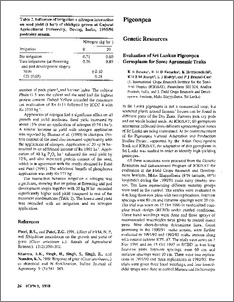Evaluation of Sri Lankan pigeonpea germplasm for some agronomic traits
Abstract
Sixty pigeon pea (Cajanus cajan) accessions collected from different agroecological zones in Sri Lanka and 10 control lines representing different maturity groups were evaluated during the 1990-91 main rainy (maha) season at Maha Illuppallama. Plots were hand weeded and sprayed with insecticides 3 times. The results showed that the germplasm available in Sri Lanka contains considerable variation for important agronomic traits. The long-duration types often found in backyards are not suitable for commercial production due to their excessive height and susceptibility to pod borers and pod fly. The short-duration group has a narrow variability for flowering, maturity and height, and some were superior in yield to the control cv. ICPL87. Major insect pests can be managed in the short-duration types, and when sown under high density with good management practices, they can yield 1.0-1.5 t/ha

